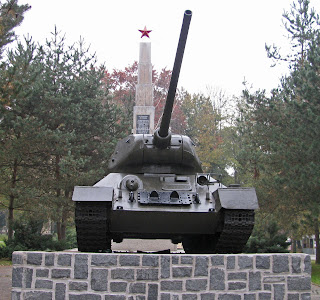Humenne with Vihorlat to the south (photo by Jan Kocak)
Humenne has been a town for over 700 years and was a small settlement before that. For centuries it was the center of a vast feudal kingdom ruled by the Drugeths, then later by the Rakoczi and Andrassy families. The manor house, or castle, built in the early 1600s still stands and is used now for offices and a museum. My ancestors were serfs bound to the Humenne Estate until about 1850, but even later some were employed at the manor house. Some of their surnames were Barna, Szorokacs, Bubnas, Kassai, Mihaly, Vadszita. During most of its history Humenne was part of the Hungarian Empire yet much of its population was Slovak or Ruthenian with thousands of Jews and even some Romani.
Drugeth Castle, Humenne
Ruins of medieval castles are found in every direction fanning out from Humenne. Some of these were already old and past their usefulness by the mid-1600s. Revolts against the Austrian Hapsburgs took their toll on the castles.
Brekov Castle (Wikipedia's photo here is way better than mine)
memorial near Snina
The first couple of times we visited Humenne (1997, 2002) it still felt like a backwater town that had not reached its potential. An unfortunate building boom during the Soviet era filled the region with ugly concrete slab apartment towers. Happily though, in 2010 Humenne is a thriving city. The central core of the city is full of new shops and businesses, a few hotels, and a very nice pedestrian park with fountains and a stage for musical performances. Optimism and prosperity permeate the air. Even at 8 in the morning the pedestrian area was busy. Further south more pedestrian areas are appearing making access to commercial areas more pleasant.
Looking south along the pedestrian mall.
Humenne core 2010 (fountain emptied for winter)
Tomorrow: my Humenne family!







I'm loving these posts -- and, yes, I'm reading them from newest to oldest.
ReplyDeleteI love this town, see another my pictures from Humenné http://www.panoramio.com/user/1549013/tags/Humenn%C3%A9
ReplyDeleteI visited Humenne in 1970, driving from Vienna to Bratislava to enter Slovakia. It was communist at the time; we were met by submachine guns at the border and required to exchange American dollars for each day of our visa. I was in search of my cousins whom we found in Humenne and villages nearby. They were children of my grandmother's brother; the family name is Lapinski. I have written to Vasil Lapinski a few times over the past years, but have not received a response and unfortunately do not have an e-mail address. My grandfather, from the same area, was Osip Kopsala. My grandparents, after immigrating, settled in Western Pennsylvania, but later moved to Niagara Falls, New York, where I was born.
ReplyDeleteYou were brave to visit during the Communist era. I don't recognize your surnames. If they were Byzantine Catholic those parish records are online at www.familysearch.org. As for locating living relatives you could send a letter to the mayor's office requesting contact with your family. I have not done that but know of people who have had success that way. Best wishes!
DeleteThank you, Suzanne, I have just now returned to this site. Yes, they were Byzantine Catholic. I will try the familysearch which you recommended. I have located my grandfather's citizenship docs and see the original spelling was Kopcala. I did write to the authorities in that area of Slovakia, but have not had any response.
DeleteHow are you related?
Joan Kapsala (current spelling) Ogelsby
San Diego, California
I have discovered the original spelling of family name, i.e. Kapcala. JKO
DeleteHave you used Facebook to locate living relatives? That has helped me make contacts.
DeleteWhich towns in Western PA did your family settle in? Mine went to Monessen, Donora, Clairton, Star Junction, and finally, Perryopolis. My family names are Bubnash, Szorokacs, Kalyanin, Barna, Maczko, Csornej, Mikula, Ihnat.
A Beautiful Town, lovely people, great food and cheap beer :) Thumbs Up from London :)
ReplyDelete